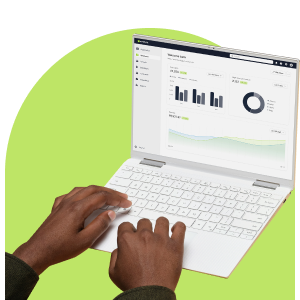Email marketing is a great way to reach and engage with your audience. In fact, Neil Patel says email is the king of marketing channels. But getting the most from your email campaigns isn’t just hit and miss – measuring and analysing your results will help you create more compelling messaging that achieves your business goals. Which metrics should you be tracking to meet these goals? Here are key ones to start with.
Goal: Increase Email Engagement
How your customers engage with your emails matters as it can increase your sales and conversions. Here are a couple of the main metrics used to monitor engagement:
- Email Open Rate
Your open rate shows how many recipients opened your email compared to the number of emails that were delivered. A high open rate is usually the result of a clear, intriguing subject line that communicates value.
It’s important to note, however, that opens are often considered a vanity metric – in other words, they don’t measure the true effectiveness of your email overall. Additionally, Apple Mail Privacy and similar data-privacy developments are also making it tricky to track opens effectively.
So, how can you use opens effectively? As mentioned above, opens are a good metric to look at when assessing the effectiveness of your email subject line. They’re also a great metric to consider in relation to other metrics, like clicks (more on click-to-open rate below).
The Everlytic benchmarks report shows that the average 2020 email open rate was just under 25% nationally. This rate can differ by industry too though, so read the report. However far off you are from the average can give you an indication of how much to re-evaluate your subject lines.
Make your emails stand out from the masses. Use the tips and best practices in this blog post to write strong email subject lines and boost your open rate.
- Email Click Rate
The email click rate measures the percentage of people who clicked a link in your email relative to how many emails were delivered. This is a great measure of how effective your email content is at enticing action.
Like opens, however, the value of the click rate isn’t always ideal when considered on its own. This is because the click rate is calculated on all emails delivered; so, it includes all recipients who haven’t opened your emails too. But it’s difficult to measure the effectiveness of an email’s content if the pool of people it’s measured on includes people who haven’t even read the email.
This is why the next metric, the click-to-open rate, is so highly regarded in email marketing.
- Click-to-Open Rate
Click-to-open rates are based on the number of clicks received from the recipients who opened your emails. This metric is considered a true track of engagement as it shows how effective the content in your email is at engaging readers and initiating action. People who haven’t opened the email are excluded from this metric entirely, giving you a clear indication of how readers respond once they’ve opened the mail.
These three metrics are all important when monitoring for engagement. Consider them in relation to each other when tracking and adapting your campaigns.

Goal: Maintain a Quality Email List
Your email marketing database can accumulate “dirty data” over time. This is because contacts change email addresses, opt out of lists, or abandon addresses they used to fill out website forms. Look at your bounce and unsubscribe rates to keep an eye on the quality of your list over time.
- Bounce Rate
Emails bounce for many reasons. For instance, a recipient’s inbox may be full, you may have the wrong email address, or you may just suffer from poor deliverability. Your bounce rate will indicate the quality of your email list by showing you how many recipients don’t receive your emails. There are two types of bounces you can track:
Soft bounces: These are often caused by a temporary delivery issue that can be solved, like a full inbox. This is unlikely though, as most inboxes are cloud based, so shouldn’t struggle with scalability.
Hard bounces: These happen when the email can’t be delivered permanently (like an email sent to an invalid email address), and emails are returned to the sending email server.
The Everlytic platform automatically removes hard bounces from lists to avoid emails being sent to those contacts again. You can also set up the SMS-on-bounce feature, which sends an SMS to any recipients whose emails bounce, asking them to update their email address. The recipient simply responds to the SMS, and the platform updates their details automatically.
You can avoid getting high bounce rates by cleaning your email list and verifying emails via double opt-in forms. Also, be consistent with your sending frequency as it can help you to spot bounced contacts quickly.
- Unsubscribe Rate
The unsubscribe rate measures the percentage of recipients opting out of your email list. This will help you analyse your list growth rate in relation to how many people are subscribing to your list in the same period. According to our 2020 Email Benchmarks Report, the average unsubscribe rate is 0.31%, which isn’t bad, but it’s still important to try minimise it.
Are your emails engaging and relevant to your subscribers’ needs? Read this post to find out why people unsubscribe and what you can do about it.

Goal: Promote Products or Services
Promotional emails are a staple across many industries. Tracking and analysing the following metrics will help you monitor how each email performs and give you insight into how you can adapt your campaigns for best results.
- Click-Through Rate
Click-through rates (CTR) show you the percentage of recipients who clicked on your email links based on the number of emails delivered. A high CTR suggests that your audience is interested in your products or services. It’s also safe to assume that someone is a potential lead if they click on a link repeatedly.
To increase your click rate, use relevant copy to highlight the value that your services or products provide in relation to the reader’s needs. You can also include email design elements, like the Z pattern, that lead your subscribers to your calls to action (CTAs).
Tip: Use this metric in an A/B test to see which version of an email performs best. This will support you to make data-driven decisions when creating and designing your emails in the future.
- Track by Device
Subscribers use different devices to open and engage with your emails and they behave differently on both. For instance, the average email open rate on mobile devices in South Africa is 23.72%, which is higher than desktop at 19.16%. Use this metric to see where your audience spends their time so you can ensure your emails are optimised for the reader’s experience.
Everlytic’s email builder and pre-designed email templates adapt to different-sized displays – ensuring that your emails look great on any device.

Goal: Generate Higher Revenue
This is the one goal most businesses have in common. Use your conversion rate and return-on-investment (ROI) data to help you build more effective email campaigns.
- Conversion Rate
This metric shows the percentage of subscribers who purchase from you via an email. To measure your conversions, look at the number of clicks versus the purchases. You can calculate the conversion rate on your emails manually using a formula or using an integration between your email platform and a tool like Google Analytics. Here is a formula you can use:
Email Marketing Conversion Rate = Number of Conversions / Number of Delivered Emails × 100
Most businesses opt to integrate their email platform with web analytics to track conversions. Creating a tracking URL for each link in your email will help you identify which email campaigns each of your conversions come from.
Tip: Optimise your content, CTAs, and email design so they increase your email conversion rate. Remember to ensure that your messages are relevant and compelling to encourage recipients to act.
- Return on Investment
Like with many other marketing expenses, you can also determine the ROI of your email marketing. This is usually in the form of your total revenue divided by the total spend. According to Litmus, the ROI on email marketing can reach as high as 44:1 – that’s $44 for every $1 spent.
The formula for ROI is:
ROI = (Final Value – Initial Value) / Costs x 100%
Manually calculating your email ROI can be tricky as you need to know how much you gained from what you spent. Use Google Analytics and tracking links (UTMs) to assess the sales received on your website from email traffic and consider this in relation to what you spend on creating those emails.
Psst! Watch our blog for a more detailed post on this, coming soon.
Up your email marketing game. Here is a list of some email best practices you can use to improve the success of your email campaigns.
Understand Your Email Metrics
Understanding what you want to achieve is always your first step. From there, the guidelines in this blog post will show you which metrics to track to determine how your campaigns are performing. Use the reports in an email platform like Everlytic and a web analytics platform like Google Analytics to track, analyse, and understand these metrics, so you can create email campaigns that meet your business goals.
Easily Monitor Your Campaign Effectiveness
Tracking your emails to see what works and what doesn’t is easier than ever with Everlytic. View detailed reporting for email and other messaging channels like SMS, web push notifications, and voice broadcasts, all on the same platform.



